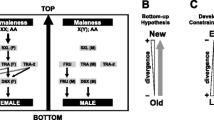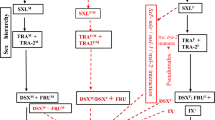Abstract
Sex-determining cascades are supposed to have evolved in a retrograde manner from bottom to top. Wilkins’ 1995 hypothesis finds support from our comparative studies in Drosophila melanogaster and Musca domestica, two dipteran species that separated some 120 million years ago. The sex-determining cascades in these flies differ at the level of the primary sex-determining signal and their targets, Sxl in Drosophila and F in Musca. Here we present evidence that they converge at the level of the terminal regulator, doublesex (dsx), which conveys the selected sexual fate to the differentiation genes. The dsx homologue in Musca, Md-dsx, encodes male-specific (MdDSXM) and female-specific (MdDSXF) protein variants which correspond in structure to those in Drosophila. Sex-specific regulation of Md-dsx is controlled by the switch gene F via a splicing mechanism that is similar but in some relevant aspects different from that in Drosophila. MdDSXF expression can activate the vitellogenin genes in Drosophila and Musca males, and MdDSXM expression in Drosophila females can cause male-like pigmentation of posterior tergites, suggesting that these Musca dsx variants are conserved not only in structure but also in function. Furthermore, downregulation of Md-dsx activity in Musca by injecting dsRNA into embryos leads to intersexual differentiation of the gonads. These results strongly support a role of Md-dsx as the final regulatory gene in the sex-determining hierarchy of the housefly.







Similar content being viewed by others
References
Agui N, Takahashi M, Wada Y, Izumi S, Tomino S (1985) The relationship between nutrition, vitellogenin, vitellin and ovarian development in the housefly, Musca domestica L. J Insect Physiol 31:715–722
An W, Wensink PC (1995a) Integrating sex- and tissue-specific regulation within a single Drosophila enhancer. Genes Dev 9:256–266
An W, Wensink PC (1995b) Three protein binding sites form an enhancer that regulates sex- and fat body-specific transcription of Drosophila yolk protein genes. Embo J 14:1221–1230
An W, Cho S, Ishii H, Wensink PC (1996) Sex-specific and non-sex-specific oligomerization domains in both of the doublesex transcription factors from Drosophila melanogaster. Mol Cell Biol 16:3106–3111
Baker BS, Belote JM (1983) Sex determination and dosage compensation in Drosophila melanogaster. Annu Rev Genet 17:345–393
Baker BS, Ridge KA (1980) Sex and the single cell. I. On the action of major loci affecting sex determination in Drosophila melanogaster. Genetics 94:383–423
Baker BS, Burtis K, Goralski T, Mattox W, Nagoshi R (1989) Molecular genetic aspects of sex determination in Drosophila melanogaster. Genome 31:638–645
Belote JM, Baker B (1982) Sex determination in Drosophila melanogaster: analysis of transformer-2, a sex-transforming locus. Proc Natl Acad Sci USA 79:1568–1572
Brand AH, Perrimon N (1993) Targeted gene expression as a means of altering cell fates and generating dominant phenotypes. Development 118:401–415
Burtis KC, Baker BS (1989) Drosophila doublesex gene controls somatic sexual differentiation by producing alternatively spliced mRNAs encoding related sex-specific polypeptides. Cell 56:997–1010
Burtis KC, Coschigano KT, Baker BS, Wensink PC (1991) The doublesex proteins of Drosophila melanogaster bind directly to a sex-specific yolk protein gene enhancer. Embo J 10:2577–2582
Chandler DS, Qi J, Mattox W (2003) Direct repression of splicing by transformer-2. Mol Cell Biol 23:5174–5185
Cho S, Wensink PC (1997) DNA binding by the male and female doublesex proteins of Drosophila melanogaster. J Biol Chem 272:3185–3189
Chomczynski P, Sacchi N (1987) Single-step method of RNA isolation by acid guanidinium thiocyanate-phenol-chloroform extraction. Anal Biochem 162:156–159
Cline TW (1993) The Drosophila sex determination signal: how do flies count to two? Trends Genet 9:385–390
Coates CJ, Johnson KN, Perkins HD, Howells AJ, O’Brochta DA, Atkinson PW (1996) The hermit transposable element of the Australian sheep blowfly, Lucilia cuprina, belongs to the hAT family of transposable elements. Genetica 97:23–31
Coschigano KT, Wensink PC (1993) Sex-specific transcriptional regulation by the male and female doublesex proteins of Drosophila. Genes Dev 7:42–54
Dubendorfer A, Hediger M (1998) The female-determining gene F of the housefly, Musca domestica, acts maternally to regulate its own zygotic activity. Genetics 150:221–226
Dubendorfer A, Hilfiker-Kleiner D, Nothiger R (1992) Sex determination mechanisms in dipteran insects: the case of Musca domestica. Semin Dev Biol 3:349–356
Dubendorfer A, Hediger M, Burghardt G, Bopp D (2002) Musca domestica, a window on the evolution of sex-determining mechanisms in insects. Int J Dev Biol 46:75–79
Erdman SE, Burtis KC (1993) The Drosophila doublesex proteins share a novel zinc finger related DNA binding domain. Embo J 12:527–535
Erdman SE, Chen HJ, Burtis KC (1996) Functional and genetic characterization of the oligomerization and DNA binding properties of the Drosophila doublesex proteins. Genetics 144:1639–1652
Guimond N, Bideshi DK, Pinkerton AC, Atkinson PW, O’Brochta DA (2003) Patterns of Hermes transposition in Drosophila melanogaster. Mol Genet Genom 268:779–790
Handler AM, Harrell RA 2nd (1999) Germline transformation of Drosophila melanogaster with the piggyBac transposon vector. Insect Mol Biol 8:449–457
Hediger M, Niessen M, Wimmer EA, Dubendorfer A, Bopp D (2001) Genetic transformation of the housefly Musca domestica with the lepidopteran derived transposon piggyBac. Insect Mol Biol 10:113–119
Hedley ML, Maniatis T (1991) Sex-specific splicing and polyadenylation of dsx pre-mRNA requires a sequence that binds specifically to tra-2 protein in vitro. Cell 65:579–586
Hertel KJ, Lynch KW, Hsiao EC, Liu EH, Maniatis T (1996) Structural and functional conservation of the Drosophila doublesex splicing enhancer repeat elements. RNA 2:969–981
Hildreth PE (1964) doublesex, a recessive gene that transforms both males and females of Drosophila into intersexes. Genetics 51:659–678
Hilfiker-Kleiner D, Dubendorfer A, Hilfiker A, Nothiger R (1993) Developmental analysis of two sex-determining genes, M and F, in the housefly, Musca domestica. Genetics 134:1189–1194
Horn C, Wimmer EA (2000) A versatile vector set for animal transgenesis. Dev Genes Evol 210:630–637
Kopp A, Duncan I, Godt D, Carroll B (2000) Genetic control and evolution of sexually dimorphic characters in Drosophila. Nature 408:553–559
Kuhn S, Sievert V, Traut W (2000) The sex-determining gene doublesex in the fly Megaselia scalaris: conserved structure and sex-specific splicing. Genome 43:1011–1020
Mattox W, Baker BS (1991) Autoregulation of the splicing of transcripts from the transformer-2 gene of Drosophila. Genes Dev 5:786–796
McDonald IC, Evenson P, Nickel CA, Johnson OA (1978) Housefly genetics: isolation of a female determining factor on chromosome 4. Ann Entomol Soc Am 71:692–694
McGregor AP, Shaw PJ, Hancock JM, Bopp D, Hediger M, Wratten NS, Dover GA (2001) Rapid restructuring of bicoid-dependent hunchback promoters within and between Dipteran species: implications for molecular coevolution. Evol Dev 3:397–407
Meise M, Hilfiker-Kleiner D, Dubendorfer A, Brunner C, Nothiger R, Bopp D (1998) Sex-lethal, the master sex-determining gene in Drosophila, is not sex-specifically regulated in Musca domestica. Development 125:1487–1494
Milani R (1967) The genetics of Musca domestica and of other muscoid flies. In: Wright JW, Pal R (eds) Genetics of insect vectors of disease. Elsevier, Amsterdam, pp 315–369
Nothiger R, Steinmann-Zwicky M (1985) A single principle for sex determination in insects. Cold Spring Harb Symp Quant Biol 50:615–621
Nothiger R, Leuthold M, Andersen N, Gerschwiler P, Gruter A, Keller W, Leist C, Roost M, Schmid H (1987) Genetic and developmental analysis of the sex-determining gene doublesex of Drosophila melanogaster. Genet Res Camb 50:113–123
Ohbayashi F, Suzuki MG, Mita K, Okano K, Shimada T (2001) A homologue of the Drosophila doublesex gene is transcribed into sex-specific mRNA isoforms in the silkworm, Bombyx mori. Comp Biochem Physiol B Biochem Mol Biol 128:145–158
Pane A, Salvemini M, Delli Bovi P, Polito C, Saccone G (2002) The transformer gene in Ceratitis capitata provides a genetic basis for selecting and remembering the sexual fate. Development 129:3715–3725
Pinkerton AC, Michel K, O’Brochta DA, Atkinson PW (2000) Green fluorescent protein as a genetic marker in transgenic Aedes aegypti. Insect Mol Biol 9:1–10
Rubini PG, Franco MG, Vanossi Este S (1972) Polymorphisms for heterochromosomes and autosomal sex-determinants in Musca domestica L. Atti del IX Congresso Nazionale Italiano di Entomologia 341–352
Ryner LC, Baker BS (1991) Regulation of doublesex pre-mRNA processing occurs by 3′-splice site activation. Genes Dev 5:2071–2085
Sarkar A, Coates CJ, Whyard S, Willhoeft U, Atkinson PW, O’Brochta DA (1997) The Hermes element from Musca domestica can transpose in four families of cyclorrhaphan flies. Genetica 99:15–29
Schmidt R, Hediger M, Nothiger R, Dubendorfer A (1997) The mutation masculinizer (man) defines a sex-determining gene with maternal and zygotic functions in Musca domestica L. Genetics 145:173–183
Schutt C, Nothiger R (2000) Structure, function and evolution of sex-determining systems in Dipteran insects. Development 127:667–677
Shearman DC, Frommer M (1998) The Bactrocera tryoni homologue of the Drosophila melanogaster sex-determination gene doublesex. Insect Mol Biol 7:355–366
Slee R, Bownes M (1990) Sex determination in Drosophila melanogaster. Q Rev Biol 65:175–204
Suzuki MG, Ohbayashi F, Mita K, Shimada T (2001) The mechanism of sex-specific splicing at the doublesex gene is different between Drosophila melanogaster and Bombyx mori. Insect Biochem Mol Biol 31:1201–1211
Suzuki MG, Funaguma S, Kanda T, Tamura T, Shimada T (2003) Analysis of the biological functions of a doublesex homologue in Bombyx mori. Dev Genes Evol 213:345–354
Tian M, Maniatis T (1993) A splicing enhancer complex controls alternative splicing of doublesex pre-mRNA. Cell 74:105–114
Tortiglione C, Bownes M (1997) Conservation and divergence in the control of yolk protein genes in dipteran insects. Dev Genes Evol 207:264–281
Vanossi Este S, Rovati C (1982) Inheritance of the arrhenogenic factor Ag of Musca domestica L. Boll Zool 49:269–278
Waterbury JA, Jackson LL, Schedl P (1999) Analysis of the doublesex female protein in Drosophila melanogaster: role on sexual differentiation and behavior and dependence on intersex. Genetics 152:1653–1667
White NM, Bownes M (1997) Cloning and characterization of three Musca domestica yolk protein genes. Insect Mol Biol 6:329–341
Wilkins AS (1995) Moving up the hierarchy: a hypothesis on the evolution of a genetic sex determination pathway. Bioessays 17:71–77
Acknowledgements
We are indebted to Drs. Rolf Nöthiger and Markus Niessen for helpful advice and stimulating discussions. Drs. Antonio Pannuti and Giuseppe Saccone are gratefully acknowledged for providing degenerated primers that were used in the initial part of this work. We would also like to thank Dr. Mary Bownes for the anti-Drosophila vitellogenin polyclonal serum and Dr. T. Adams, Fargo, N.D. for his gift of anti-Musca vitellogenin antibodies. We thank Claudia Brunner for technical assistance and Raymond Grunder and Johanna Nägeli for husbandry of the Musca stocks. This work was supported by a grant of the Swiss National Foundation (3100.067993.02/1) and a Novartis fellowship to M.H.
Author information
Authors and Affiliations
Corresponding author
Additional information
Edited by D. Tautz
Rights and permissions
About this article
Cite this article
Hediger, M., Burghardt, G., Siegenthaler, C. et al. Sex determination in Drosophila melanogaster and Musca domestica converges at the level of the terminal regulator doublesex . Dev Genes Evol 214, 29–42 (2004). https://doi.org/10.1007/s00427-003-0372-2
Received:
Accepted:
Published:
Issue Date:
DOI: https://doi.org/10.1007/s00427-003-0372-2




